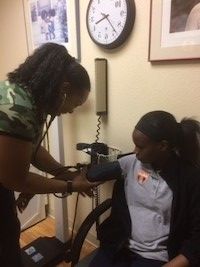Article
Pediatricians Miss Chances to Address Children's Blood Pressure
Author(s):
In visits with overweight or obese children with high blood pressure, pediatricians either provide no communication about BP or unclear or dismissive statements, unless SBP is ≥120 mmHg.

A nurse checks a child’s blood pressure.
Credit: American Heart Association
Most children with overweight or obesity who have high blood pressure (BP) do not receive information from their pediatrician about the elevated BP at well-child visits, according to a study to be presented at the American Heart Association Scientific Sessions 2018 in Chicago, IL.
Investigators found that communication from pediatric providers about high blood pressure was direct in 16.6%, unclear in 16.6%, minimized in 13%, and absent in 66.7% of recorded visits.
“High blood pressure (BP) in children is under recognized by pediatric providers,” wrote the authors, Nora Bismar, BS, University of Texas Southwestern, Dallas, TX; Tammy M Brady, MD, PhD, Johns Hopkins School of Medicine, Baltimore, MD; and Christy B Turer, MD, University of Texas Southwestern, Dallas, TX. “Our aim was to describe and determine factors associated with provider communication of high BP during visits with a child with an elevated BP.”
The study was a cross-sectional analysis of 30 video- or audio-recorded well-child visits with 23 providers for children ages 6-12 who were overweight or obese. Investigators determined elevated blood pressure and hypertension by applying pediatric hypertension thresholds to blood pressure data stored in electronic health records.
The mean age of pediatric participants was 8.7 years. Patients were 37% overweight, 63% obese; and 37% Black, 47% Latino.
Visit transcripts were analyzed by independent reviewers who identified whether information about the child’s elevated blood pressure was communicated during the visits and established communication themes, which included direct, unclear, minimize, and absent.
Direct communication included statements such as, “Your BP's a little bit high. 120 is the highest we want for her age,” while unclear communication included, “The biggest reason I worry about this [obesity] is you can start having adult problems like high BP."
An example provided of a minimizing statement came from a visit with an 8-year-old patient whose blood pressure was 114/75, “BP is a bit high. He's just nervous.”
Using a chi-square test, investigators determined that a systolic blood pressure (SBP) above the adult elevated levels (≥120 mmHg) was associated with direct communication about the child’s blood pressure. This direct communication occurred in 80% of visits with SBP ≥120 mmHg compared to 20% of visits with SBP <120 mmHg (P = .047).
“During well-child visits, most overweight children with high BP receive no communication that BP is high,” wrote Bismar, Brady, and Turer. “Of those who do, communication commonly is unclear or dismissive, and more likely when SBP exceeds the adult high-BP threshold.”
The investigators also found that themes such as therapeutic lifestyle counseling and follow-up information were identified as present in 10% of recorded visits.
The presentation, “Treating Children Like Little Adults: Pediatrician Communication About High Blood Pressure Includes Diminution and Targeting Children With High Systolic Blood Pressures Exceeding Adult Thresholds,” will be given on Saturday, November 10 at the AHA Scientific Sessions 2018.





